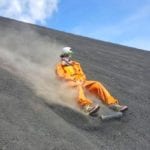 The Arts
The Arts  The Arts
The Arts  Crime
Crime 10 Fascinating Facts about Rikers Island
 Pop Culture
Pop Culture 10 Things You Might Not Know about Dracula
 Weird Stuff
Weird Stuff 10 Everyday Activities That Were Once Considered Illegal
 History
History Ten of History’s Hidden Secrets: Stories 99% Don’t Know About
 Movies and TV
Movies and TV 10 Actors Who Infamously Stormed Off Set While Filming
 Food
Food 10 Foods That Have Alleged Occult Powers
 Sport
Sport 10 Lesser-Known Multi-Sport Alternatives to the Olympics
 Humans
Humans 10 Real Life Versions of Famous Superheroes
 Gaming
Gaming 10 Overused Game Villains
 The Arts
The Arts 10 Masterpieces Plucked from the Artist’s Subconscious
 Crime
Crime 10 Fascinating Facts about Rikers Island
 Pop Culture
Pop Culture 10 Things You Might Not Know about Dracula
Who's Behind Listverse?

Jamie Frater
Head Editor
Jamie founded Listverse due to an insatiable desire to share fascinating, obscure, and bizarre facts. He has been a guest speaker on numerous national radio and television stations and is a five time published author.
More About Us Weird Stuff
Weird Stuff 10 Everyday Activities That Were Once Considered Illegal
 History
History Ten of History’s Hidden Secrets: Stories 99% Don’t Know About
 Movies and TV
Movies and TV 10 Actors Who Infamously Stormed Off Set While Filming
 Food
Food 10 Foods That Have Alleged Occult Powers
 Sport
Sport 10 Lesser-Known Multi-Sport Alternatives to the Olympics
 Humans
Humans 10 Real Life Versions of Famous Superheroes
 Gaming
Gaming 10 Overused Game Villains
16 Most Dangerous Volcanoes In The World
Scientists simplify things to help us laypeople understand volcanoes. The reality, of course, is more complicated.
Every volcano is unique. Volcanologists must learn each individual “personality” and history when they try to help people living nearby.
With limited resources, though, how do you choose which volcanoes to study? Here’s how: When the United Nations made the 1990s its International Decade of Natural Hazard Reduction, volcanologists decided to focus on 16 volcanoes; two each from the US, Japan, and Italy; one each from 10 other countries.
One of these Decade Volcanoes — Taal, in the Philippines — is making headlines right now.
SEE ALSO: Top 10 Amazing Volcano Lakes
16 Taal Volcano, Philippines
Taal made international news with its dramatic eruption in January 2020. The ongoing situation is still volatile, so let’s just look at it as a Decade Volcano.
Well over 20 million people live near Taal, located only 30 miles south of Manila, the nation’s capital. Human risk alone made Taal a candidate for the Decade Volcano list in the 1990s. But Taal also has been very active down through the centuries, as well as a couple eruptions in the distant past powerful enough to have left calderas (holes in the ground, basically) that eventually filled in with Lake Taal.
Communication is important in volcanology, too. Scientists and regional planners worked together as part of the Decade Volcano program to limit intensive development inside the caldera. This foresight has probably made the current crisis a little easier to manage.
15 Avachinsky-Koryaksky, Russia
Population at risk: Over 200,000 people live within 62 miles (100 km) of these two volcanoes on the Kamchatka Peninsula in the Russian Far East.
Last known eruption: Avachinsky, 2001; Koryaksky, 2009
The flip side of living dangerously close to an active volcano? All the fun you can have during quiet spells! The people in the video here, for instance, summited Avachinsky one sunny day and also got excellent views of nearby Koryaksky.
Avachinsky looks so solid there. It’s hard to believe that this volcano sometimes collapses. However, nearby Petropavlosk (the largest city in Kamchatka) was built on deposits left by one such prehistoric catastrophe. Mud flows and lava are more likely hazards and can happen at either volcano. Petropavlosk is so isolated that its residents will have to wait for aid to arrive by land and sea during a volcano emergency.
14 Colima, Mexico
Population at risk: 1.5 million people
Last known eruption: 2019
Colima, a complex volcanic center near the western coast of Mexico, presents multiple hazards, in addition to being a threat to population centers. For one thing, it has frequent violent eruptions: like the one here in 2017, caught on monitoring cameras.
Almost all Decade Volcanoes are in subduction zones, which usually produce explosive volcanism. Such explosions cause blast effects, ballistic rocks and lava bombs, and pyroclastic flows. As you can see, they even ignite wildfires. And Colima does this over and over again. In past millennia, it has also had several large debris slides.
After making the Decade Volcano list, new hazard maps were made for Colima and its monitoring post was restructured.
13 Etna, Italy
Population at risk: A quarter of Sicily’s entire population lives on Etna’s slopes.
Last eruption: 2020
Everyone knows this one! Etna is a UNESCO site and has one of the longest historical eruption records of any active volcano, going back some 3,500 years. One look at its spectacular lava flows will tell you why Etna was selected as a Decade Volcano.
The footage above was filmed in 2011 near the town of Zafferna, which only exists today because of coordinated efforts in 1992 that succeeded in damming and then diverting a lava flow that threatened to overwhelm the town.
That kind of success doesn’t happen very often during an eruption. Lava and occasional hydrothermal blasts like this are the chief hazards at Etna. However, Sicily is heavily dependent on Etna tourism as well as on agricultural products grown on the volcano, so any increased activity would also have bad economic effects.
12 Galeras, Colombia
Population at risk: Almost two million people
Last known eruption: 2014
A tragedy happened at this flat-topped stratovolcano in 1993, when some tourists as well as six volcanologists, who were participating in a Decade Volcano workshop, were killed by an unexpected eruption. Activity at Galeras before and during that risky field trip was heavily monitored, of course, but no one had ever before seen the seismic signals called “tornillos” that came just before the blast.
Now everyone knows that tornillos are warning signs of imminent explosive activity, a scientific discovery that carried a heavy cost. Galeras is one of Colombia’s most active volcanoes. Above, its fireworks in 2008 light up the sky over the nearby city of Pasto. Hazards include debris flows, large eruptions with heavy ash fall, and pyroclastic flows.
11 Mauna Loa, USA
Population at risk: 175,000 people
Last known eruption: 1984
You might think that Mauna Loa is just that long, low mountain near Kilauea; the Hawaiian volcano that had a spectacular eruption in 2018. Mauna Loa is actually the tallest active volcano on Earth, rising almost six miles above the Pacific sea floor. It has frequent eruptions, too. In 1984, a lava flow came within five miles of the city of Hilo.
Lava is the main hazard here, although Mauna Loa also has had some flank collapses in the very distant past. Fortunately, the Hawaiian Islands are nowhere near a subduction zone, and eruptions here are usually not as explosive.
Volcanologists are watching Mauna Loa closely, since it appears to be slowly building up to another eruption, but they’ve seen no reason to raise the alert level any higher than it is now (yellow, the lowest warning stage).
10 Mount Merapi, Indonesia
Population: Almost 25 million people
Last known eruption: 2019
Much international collaboration has focused on Merapi during the Decade Volcano program, it’s one of Indonesia’s most active volcanoes and sits in a heavily populated region. Merapi’s eruptions are violent, too, with long-lived pyroclastic flows.
Besides those terrifying gray death clouds, hazards at Merapi include lahars (an Indonesian word for mud flows) and big landslides. The worst eruption from Merapi recently, in 2010, killed over 100 people.
9 Nyiragongo, Democratic Republic of the Congo
Population at risk: A little over nine million people live within 62 miles (100 km); a million of them are less than 20 miles from the summit.
Last known eruption: 2019
This African volcano has a flattish top like Galeras, in South America. Unlike Galeras, Nyiragongo has hosted a series of lava lakes for centuries. That’s a deadly hazard, because those lakes drain every few decades and the lava is extremely fluid, meaning it an travel long distances, even into the nearby city of Goma.
This has happened twice recently: in 1994, during the civil war, and again in 2002, when it killed about 150 people in addition to causing enormous damage. Unfortunately, warfare and social problems have limited what international volcanologists can do here. But local hands have taken up the task of researching and monitoring this Decade Volcano.
8 Mount Rainier, USA
Population at risk: Almost three million people
Last known eruption: 1450 AD (Eruptions during the 1800s have been reported but not confirmed.)
This world-famous landmark near Seattle, Washington, had its last big blast (a VEI 4 eruption) about 2,200 years ago, but that’s not the only hazard. Mount Rainier, which is heavily glaciated, tends to collapse, causing enormous mud flows. This hasn’t happened during recorded history.
The residents of Armero, Colombia, weren’t so fortunate in 1985. While their ice-capped volcano, called Nevado del Ruiz, didn’t collapse, its lava melted summit glaciers and sent down a mudflow that engulfed Armero and other communities, killing over 23,000 people.
There was lots of warning, but nobody expected this. Thousands died who could have simply run a few hundred yards to safety. The Armero tragedy was a major factor behind both the UN hazard reduction declaration and the Decade Volcano project.
Partly as a result of all this attention, Mount Rainier now has better monitoring and hazard mapping. As well, some legislation is in place to reduce future development in high-risk zones and promote public awareness of the threats here. But many people near Rainier are still in denial. That’s understandable, though very sad: It’s human nature to never really believe that such a bad thing can happen to you, until it does.
SEE ALSO: 10 People Who Actually Fell Into A Volcano
7 Sakurajima, Japan
Population at risk: 2.6 million people
Last known eruption: 2019
You might not have heard of this volcano, which sits on the same island as Mount Fuji, but farther south. The world-renowned Fuji-san is a dire threat to Tokyo and the subject of intense research. Perhaps the Decade Volcano selection committee went with Sakurajima instead because this dangerous volcano isn’t as well known. After all, you haven’t seen the above happening in Tokyo recently.
But that 2013 video shows one of the hazards that citizens of Kagoshima City, less than five miles from Sakurajima, often face. Sakurajima Volcano used to be an island in Kagoshima Bay until 1914, when one of its explosive eruptions also unleashed lava flows that connected it to the mainland.
Now thousands of people live in the area, Kids there wear hardhats, just in case it rains stones on the way to school.
6 Santa Maria/Santiaguito, Guatemala
Population at risk: 6,200,000 people
Last eruption: 2019
This is not two separate volcanoes, as with Avachinsky and Koryaksky on Kamchatka.
Here, “Santa Maria” is the stratovolcano and “Santiaguito” is what people call the lava dome complex near the summit. Santiaguito has frequent minor eruptions. Also, the domes sometimes collapse, which cause pyroclastic flows. Larger explosions and mudflows are also possible.
Nevertheless, lots of people still enjoy climbing 12,300-foot-high Santa Maria so they can look down on an eruption and take silly pictures. That dome complex has existed since 1929, when Santa Maria ended 27 years of violent eruptions that killed over 7,000 people. But Santa Maria/Santiaguito’s Decade Volcano status hasn’t led to many government-financed projects yet.
Guatemala has lots volcanoes that demand attention. Officials still need to be convinced that preparation before another major eruption here will be less expensive than coping with the aftermath of one later.
5 Santorini, Greece
Population at risk: 67,500
Last known eruption: 1950
Volcanologists are curious about the eruption history that gave Santorini — also known as Thera — its dramatic appearance. They have identified at least four caldera-forming events over the last 180,000 years. The most recent, roughly 3,600 years ago, was a VEI 7 eruption.
That’s the one that may have doomed Minoan civilization, which centered on the nearby island of Crete. Or not. No one is really sure yet what closed down that amazing culture. Thanks to the Decade Volcano program, Santorini now has its first modern volcano observatory. So far, it has detected only occasional swarms of seismic activity, nothing that looks like an impending eruption.
4 Teide, Canary Islands
Population at risk: 766,000 people
Last known eruption: 1909
Actually, the entire island of Tenerife is a complex of stratovolcanoes that have been active since the Miocene times. Teide is just the highest, and also one of the youngest. Teide sits in 6 x 11-mile-wide Las Canadas caldera, and the view from the top is tremendous! Those sulfur-producing fumaroles up there are the only visible sign of current activity. Teide has also had some earthquake swarms but is otherwise quiet.
3 Ulawun, Papua New Guinea
Population at risk: 61,000 people
Last known eruption: 2019
You might not have heard of this island volcano in the South Pacific, but (along with contributions from an equally obscure Russian fire mountain) Ulawun gave you purple sunsets last year. Ulawun is one of Papua New Guinea’s most active volcanoes. Its eruptions, though explosive, used to be fairly minor until the 1970s. From that point on, larger blasts became more common, including a VEI 4 eruption in 2000.
At the moment, this gorgeous tropical stratovolcano is once more behaving like one of The Daily Planet‘s mild-mannered reporters. We’ll just have to stay tuned and see what happens next.
2 Unzen, Japan
Population at risk: 7,300,000 people
Last known eruption: 1996
Yes, this is the one that killed volcanologists Harry Glicken, Katia Krafft, and Maurice Krafft, along with 40 other people in 1993. Unzen isn’t so much a single volcano as it is a mashup of three large stratovolcanoes and several lava domes, taking up most of the Shimabara Peninsula east of Nagasaki.
Pyroclastic flows are a major hazard here. And sometimes collapsing material falls into the sea, generating tsunamis like the one in 1792 that accounted for most of the 14,000-plus casualties from Unzen that year.
Unzen awakened in 1990, forcing evacuations and destroying more than 2,000 buildings near Shimabara City. All is quiet now, but when Unzen stirs again, activity forecasts will be more accurate thanks to data obtained from Decade Volcano studies and other research.
1 Vesuvius, Italy
Population at risk: More than 6 million people
Last known eruption: 1944
You knew Vesuvius would be on the list, all because of the video above.
Yes, that’s what a VEI 5 eruption looks like close up. The only typical volcanic hazards not shown in this animation are lava, gas, and tsunamis, though these all claimed victims that day, too. Pyroclastic flows, lava, and gas have killed people and caused massive damage during other Vesuvius eruptions, including the last one in the 1940s. Tsunami-generating landslides into Naples Bay are possible, too.
While everyone has been aware of the hazards here for centuries, the issue was first addressed during the Decade Volcano program. Now, emergency plans based on the Pompeii eruption and another powerful eruption in 1631 are in place and reviewed regularly.
It’s not easy to evacuate Naples and surrounding areas, but Vesuvius will not catch scientists and emergency personnel sleeping the next time it roars to life. The worst volcano in the world is always going to be the one erupting near you, whether it’s on a scientific list or not, but thanks to the Decade Volcano program, lessons have been learned that help people survive and manage a volcanic crisis wherever it occurs.
SEE ALSO: Top Common Misconceptions About Volcano Eruptions








